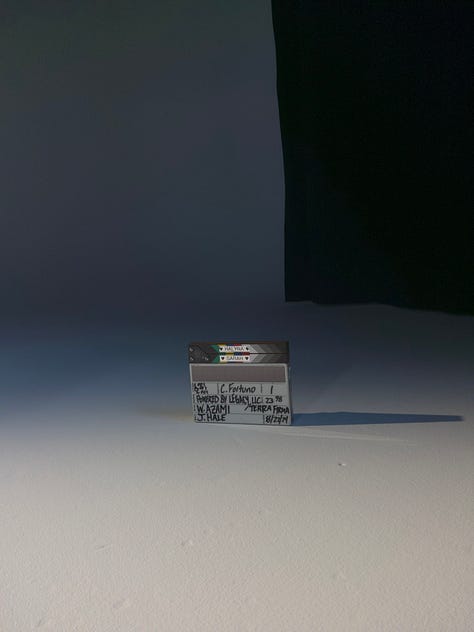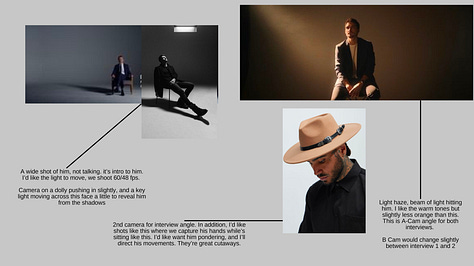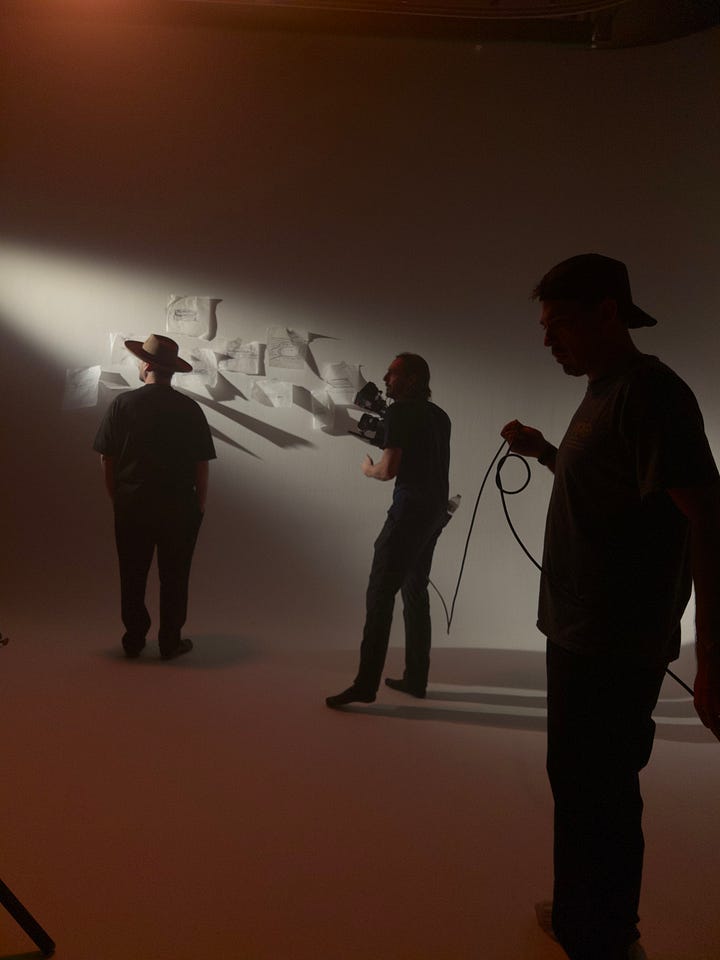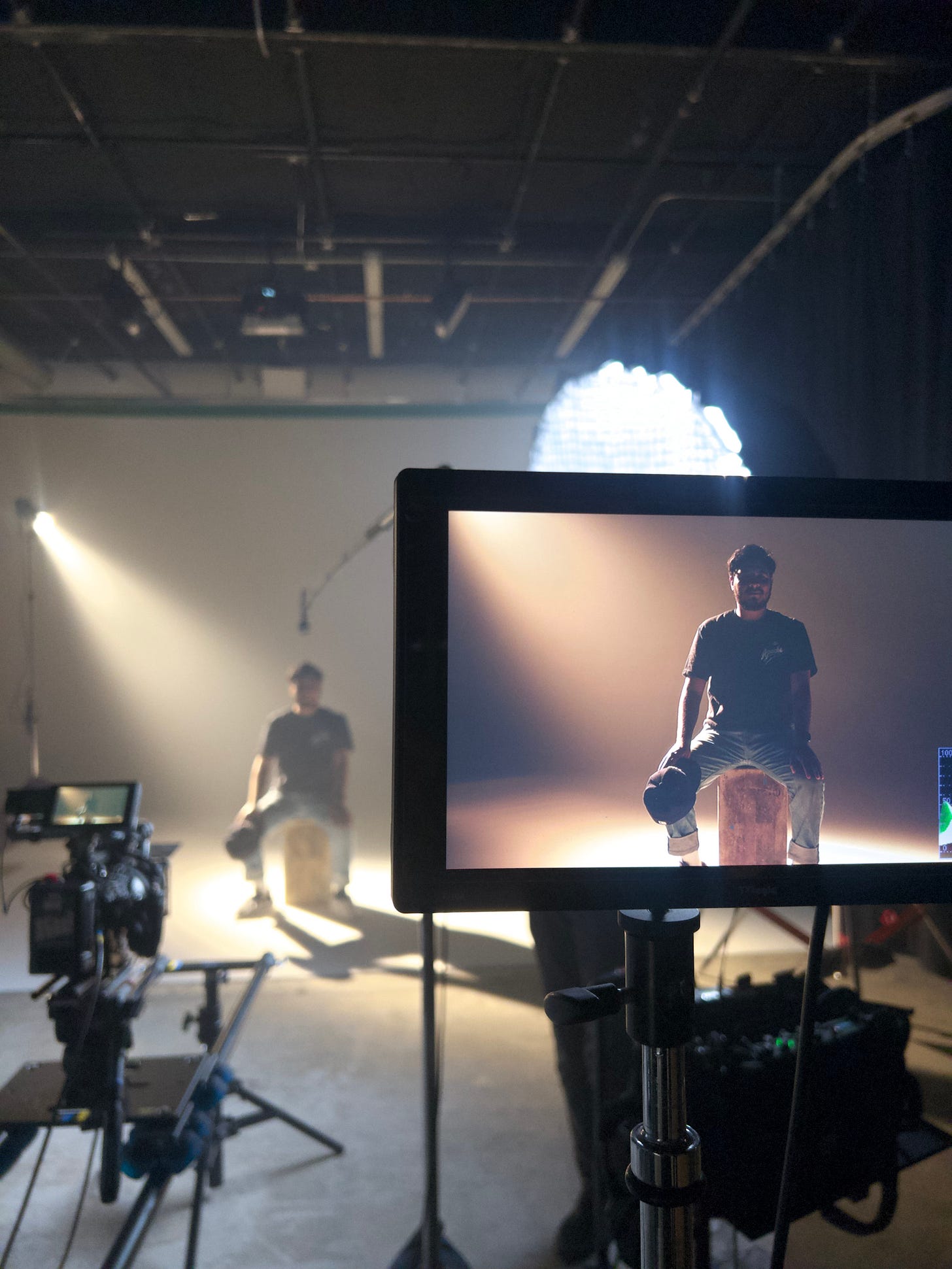Behind the Scenes: Crafting the Perfect Commercial Shoot
Welcome to a sneak peek into the meticulous planning that goes into one of my photo or commercial shoots. Every detail matters when you are communicating to a team of creatives, and I'm excited to share how I approach this creative process.
Creatives can be … well, quite creative. And when I say “moody lighting” that’s something entirely different from one person to another. A mood board protects us and keeps everyone on the same page.
With a mood board, they know what type of “moody lighting” I’m talking about and we get to our goal faster. I take out the guessing work for the director of photography, gaffer and other members.



Photoshoot Wardrobe Inspiration
For a recent shoot, the focus was on ensuring that the clothing would complement the scene without overshadowing the subject. I requested that all outfits be tucked in or form-fitting to emphasize the silhouette, an essential element since we planned to incorporate silhouette shots. The choice of super plain attire ensures that the talent blends seamlessly into the setup, maintaining the focus on the scene's mood rather than their fashion.
In addition, solid colors and plain attire meant the video wouldn’t be dated as much and they client would have the luxury of using it much longer.
Originally the board went to the talent, so that he knew how to dress. Then I shared the board with my Director of Photography. This would factor in to his suggestions for lighting. It wouldn’t dramatically change anything, but it would offer him all of the puzzle pieces to figure out lighting.
Communicating with the DP
Clear communication with the Director of Photography (DP) is crucial. I sent over a meticulously detailed board outlining every aspect of what I envisioned. This included specific instructions on camera movements—like a dolly push-in to reveal the subject—and lighting effects, such as a carefully crafted ray of light paired with just the right amount of haze to create atmosphere without overpowering the scene.
The boards you see are conversational dialogue that I had with my DP. I don’t share the boards with the client or anyone else on set. It’s a visual text between the director and the DP.



The notes are explicit and they are loose enough for my DP to make decisions, from the overall ambiance down to the details of lighting on the subject’s face. The request detail extends to the camera angles and the narrative each shot is meant to convey. Then they’re followed up with phone calls and we collaborate on ideas. Then on set, we further collaborate and make suggestions.
Director X DP Collaboration
Here’s how collaboration works with my shoots:
Pre-Production: Through a series of phone calls, texts and emails - we hammer out the details from selecting the studio/set, to the type of lights we’ll use, to the crew that I hire, and everything else shown on camera.
Production: During production, the director of photography (at least on my set) gets about 90 minutes of solo-work. That means he works with his gaffer and grip to set up about 80% of the shot, according to our pre-production conversations.
Then I’ll come in as the director. I’ll make any changes from positioning the talent marker to asking for more/less haze. I’ll ask for light to move a little, soften or harden. We’ll talk about lighting temperature and go back-and-forth until we have the desired look.
Finally, the talent comes from wardrobe and sits/stands on their marker. By now we’ve reached about 95% perfection. The last 5% of adjustments happen because each person reads different on camera, under the lights. We might add a flag, or simply remove a light. In this case, we did both!
Post-Production: Once we have the footage “in the can” it’ll go to my editor. I’ve asked Zach (my editor) to not edit for 3 days. This is a deliberate decision as I respect the creative process and we are not machines. I don’t want to employ machines, I create with artists and they need a moment to gather inspiration.
Actually here are my steps:
Allow the editor to do NOTHING with the footage for 3 days. Thinking is also working and it’s important work.
Allow the editor to create as they want, I won’t poke my nose in besides the first round of notes.
Watch the first cut, give notes, and do this a few times until I’m happy enough to show the client.
Show the client V2 or V5, whatever it takes and which ever version is good enough.
Wait for client notes and then have the editor make additional changes based on their notes.
Give the client the new version and get the green light to picture lock. Picture lock means, we’re locked and no new changes (besides color and titles).
Ask the editor for 3 color treatments based on the notes.
Take the 3 ideas and have a conversation with my DP. We’ll just discuss, debate, agree, debate some more and compile the notes for my colorist. As the director, I have the final say. I respect the word of my DP but the project is directed by me. Remember that on your own shoots.


Final Thoughts
This structured approach—paragraph by paragraph, line by line—is how I ensure that everyone involved in the shoot is on the same page. It eliminates guesswork and enhances the shoot's efficiency, leading to a product that everyone can be proud of.
Remember, the specifics of how I manage my shoots are tailored to my style and needs—you don't have to replicate them. What's important is finding a process that ensures you achieve the best results and truly satisfies your creative vision.

If You Don’t Know How to Charge
All of this information is useless if you don’t understand how to charge properly. If you aren’t fairly compensated, then put your camera down and learn pricing first. Imagine going through all of this hassle and getting underpaid. Yikes!
The S.T.E.P. Pricing course that I offer will change that. Simply put, it will change the entire direction of your career, as it has for many others. If you are interested, check it out here. If you feel your pricing is great and you’re making enough money, then don’t worry about it.
https://go.photographybusinesscourse.com
Here's to creating stunning visual narratives and remembering that in the world of photography, your unique approach to every detail matters. Whether you're a seasoned photographer or just starting, never underestimate the power of well-planned execution.
Please consider sharing this with someone who could benefit from it.








Share this post